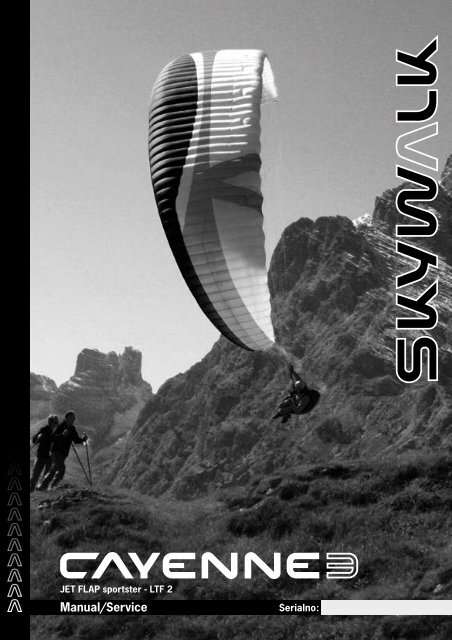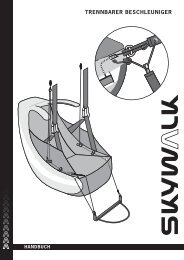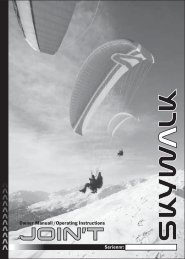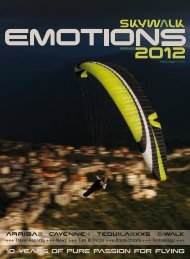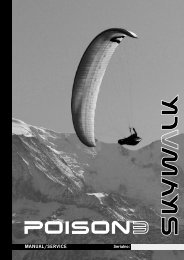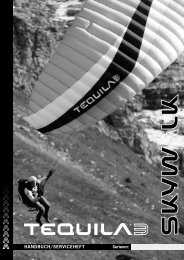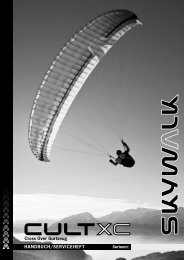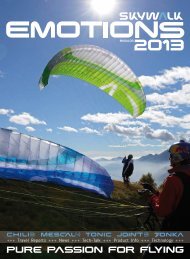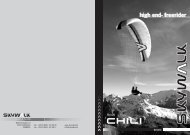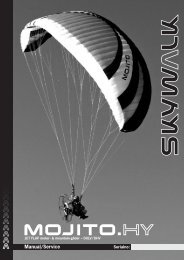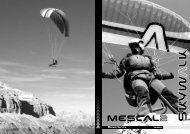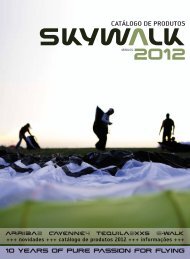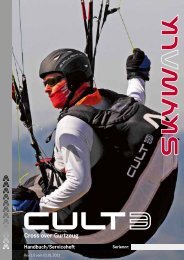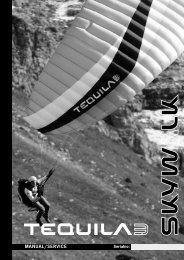Operating Instructions - Skywalk
Operating Instructions - Skywalk
Operating Instructions - Skywalk
You also want an ePaper? Increase the reach of your titles
YUMPU automatically turns print PDFs into web optimized ePapers that Google loves.
JET FLAP sportster - LTF 2<br />
Manual/Service<br />
37
ConTEnT<br />
38<br />
Introduction<br />
Description, Technical Data, Line System<br />
Speed System<br />
Harness<br />
Flying Praxis and Properties<br />
Landing<br />
Extreme Flight Manoeuvers<br />
Materials<br />
Maintenance, Disposal<br />
2-Year Check<br />
Homologation<br />
nature and Ecological Compatibility<br />
Closing Words<br />
Line Plan,<br />
Risers<br />
Inspection Protocol
InTRoDuCTIon<br />
Congratulations and thank you for purchasing a skywalk glider! We can assure<br />
you that this decision will reward you with plenty of pure passion for flying.<br />
To ensure that you feel at home on your new glider, we recommend you thoroughly<br />
read the Owners Manual/<strong>Operating</strong> <strong>Instructions</strong>. This way you will get to know your<br />
skywalk CAYENNE3 in a quick and simple manner.<br />
The following instructions will help to keep your skywalk CAYENNE3 in excellent<br />
condition, to use it safely and enjoy it for a very long time.<br />
If you have any questions, remarks or suggestions for improvement,<br />
please do not hesitate to contact us by fax, e-mail or phone.<br />
The skywalk-team is always happy to be of service.<br />
Your skywalk-team<br />
39
40<br />
DESCRIPTIon<br />
It was a difficult task to develop a worthy successor to the CAYENNE2 . A class 2 glider<br />
has to include just about everything.<br />
Maximal performance stands side by side with high feel-good factor as a top criteria.<br />
This determines if the pilot can get the maximum performance from his glider.<br />
Handling has to be excellent, if not developed exactly for Acro-flying, because only<br />
when the pilot has the glider under control in any weather condition can he fully utilise<br />
the performance potential.<br />
Whether novice cross country pilot or OLC kilometer-chaser, as cross country pilot<br />
one frequently encounters demanding conditions. Here, the wheat is quickly separated<br />
from the chaff and the pilot will find out how the glider handles, and whether he can<br />
control it.<br />
In the CAYENNE3, we have implemented everything which is currently technically feasible,<br />
setting new standards on the way. Optimal performance was the goal from the<br />
very first day.<br />
A purebred 3-liner, thinner mid- and top-lines with loop sleeve, drag-optimised risers, 5<br />
continuous strain relief bands, JET FLAPS...these are a few of the technically innovative<br />
features accompanying the CAYENNE3 to the launch.<br />
We have saved 40% in line drag alone in comparison with the CAYENNE3’s predecessor<br />
through the implementation of high-tech lines in the line system.<br />
Owing to the continual optimisation of our CAD Software, we can be even more exact<br />
in our development parameters. Only through constant advancement is it possible to<br />
stand again and again at the peak of the technological standards.<br />
Naturally, we couldn’t leave out the JET FLAPS, implemented in all of our gliders. JET<br />
FLAPS are becoming ever more important in order to guarantee pilot safety at such<br />
long distances. Brake travel is becoming shorter due to the low cord length. The JET<br />
FLAPS compensate this loss perfectly and allow enough steering way.<br />
The CAYENNE3 speaks to mileage-hounds as well as those looking to trade up from<br />
the upper LTF 1-3 range (e.g: CHILI pilots).<br />
Your skywalk Team
TECHnICAL DATA<br />
Size XS S M L XL<br />
Cells 61 61 61 61 61<br />
Area 22.24 25.34 26.41 27.83 29.50<br />
Wingspan 11.55 12.33 12.59 12.93 13.30<br />
Aspect Ratio 6.00 6.00 6.00 6.00 6.00<br />
Area Projected 18.70 21.30 22.20 23.40 24.80<br />
Wingspan .proj. 8.97 9.57 9.77 10.03 10.33<br />
Aspect Ratio proj. 4.30 4.30 4.30 4.30 4.30<br />
Canopy Weight kg 4.9 5.6 5.9 6.2 6.6<br />
Take off Weight in kg 60-80 75-100 85-110 95-120 105-130<br />
min. Speed in km/h 22 22 22 22 22<br />
Trim Speed in km/h 39 39 39 39 39<br />
max. Speed in km/h 56 56 56 56 56<br />
Winch Towing yes yes yes yes yes<br />
Jet Flap Technology yes yes yes yes yes<br />
Motor certification no no no no no<br />
with special risers<br />
ATTEnTIon:<br />
THE HoMoLAGATIon TAG CAn BE FounD In A PoCKET on THE MIDDLE<br />
PRoFILE RIB. In GERMAnY, THE HoMoLoGATIon BADGE MuST BE<br />
ATTACHED To THE GLIDER. IF THERE IS no BADGE ATTACHED, THE<br />
SKYWALK SEAL MuST BE VISIBLE. THIS SEAL CERTIFIES THAT THE GLIDER<br />
IS IDEnTICAL In ConSTRuCTIon To THE MoDEL InSPECTED AT THE<br />
HoMoLoGATIon LoCATIon. IF THE SEAL IS MISSInG, IT CAn BE ASSuMED<br />
THAT THE GLIDER IS A PRoToTYPE WHICH HAS noT BEEn InSPECTED.<br />
CAuTIon:<br />
THE TYPE SHEET IS PRInTED onTo THE InSIDE oF THE STABILo. DATE AnD<br />
nAME oF THE PILoT oF THE FIRST FLIGHT HAVE To BE EnTERED!<br />
41
42<br />
LInE SYSTEM<br />
The lines of the Cayenne 3 represent an ideal compromise in durability and low drag.<br />
The material mix of covered main lines (Dyneema and Aramid) as well as uncovered<br />
Technora lines guarantees the best mechanical strength properties with minimal drag.<br />
A cover is sewn on the loops at the connection on the mid lines as well as the top lines<br />
in order to guarantee the best possible transmission of energy. It was possible with this<br />
combination of materials as well as the laborious loop sleeves to reduce drag by 40%<br />
in comparison to its predecessor.<br />
The CAYENNE3 is a purebred 3-liner system – which means it operates solely over 3<br />
line levels. 3 A, 3 B, 3 C, as well as 1 stabilo line. This means also that it has only A, B<br />
und C connection points.<br />
The skywalk CAYENNE3 has 4 risers on each side.<br />
> The A-lines lead to the A-riser.<br />
> The B-lines as well as the stabilo lines lead to the B-riser.<br />
> The inner and outer C-lines lead to the C1-riser.<br />
> The middle C-lines lead to the C3-riser.<br />
A schematic illustration of the risers can be found on page 63 and next.<br />
IMPoRTAnT SAFETY WARnInG:<br />
FLYInG A PARAGLIDER REquIRES MAXIMuM CAuTIon AT ALL TIMES.<br />
BE AWARE THAT FLYInG YouR PARAGLIDER IS DonE AT YouR oWn RISK. AS<br />
A PILoT You MuST GuARAnTEE THE AIRWoRTHInESS oF YouR PARAGLIDER<br />
BEFoRE EVERY SInGLE FLIGHT.<br />
Don’t use your skywalk CAYEnnE3:<br />
> Outside the certified take-off weight<br />
> With any engine<br />
> In rainy, snowy and extremely turbulent weather conditions or high winds<br />
> In fog or clouds<br />
> With insufficient experience or training<br />
Every pilot is responsible for his own safety and will have to ensure that his aircraft<br />
(paraglider) has been checked and serviced for airworthiness before flying.
You can only fly your skywalk CAYENNE3 with a valid flying license and in accordance<br />
with local rules and regulations.<br />
During production, your skywalk CAYENNE3 has passed several thorough quality<br />
control checks. More spot checks were performed before shipping<br />
SPEED SYSTEM<br />
The skywalk CAYENNE3 can be equipped with a foot-operated speed system.<br />
The speed system works on the A-,B- and C1-risers.<br />
All risers are equal in length before activation of speed system. The CAYENNE3<br />
has a very efficient speed system travel thanks to the 3-line system.<br />
When operated, the A, B and C1 risers are shortened.<br />
To what degree the risers are shortened can be seen on page 63 nd next.<br />
Each size glider has its own risers as well as speed system length.<br />
CAuTIon:<br />
THE DHV RATInG oF SoME GLIDER SIZES CAn CHAnGE DuRInG THE uSE<br />
oF THE SPEED SYSTEM WHILE FLYInG. To DETERMInE WHICH SIZES<br />
ARE AFFECTED PLEASE CHECK THE TYPE SHEET.<br />
Installing the Speed System equipment:<br />
Most commonly used harnesses have pulleys for the speed system already<br />
attached. The speed-system line runs from the front through the pulleys at the harness<br />
to the top. They are tied to the ”Brummel-hooks” at the appropriate length.<br />
With the correct adjustment of the speed system lines, the foot-bar can be reached<br />
easily angled during flight. By straightening the legs, the entire speed range can<br />
be used. Prior to flying, the connection hooks of the foot-operated accelerator and<br />
the acceleration system have to be connected to each other (Brummel-hooks).<br />
Check that the speed system line runs freely.<br />
43
Function:<br />
By using the foot-operated accelerator, the pilot reduces the force by half via a pulley<br />
system and shortens the A-, B- and C-risers.<br />
HARnESS<br />
The skywalk CAYENNE3 is licensed for all certified harnesses of the GH type<br />
(harnesses without solid cross-bracing).<br />
Be aware that the level of suspension changes the relative braking distance.<br />
Recommendation: Our RANGE competition harness is perfect for combining with the<br />
cross country glider CAYENNE3. The CULT XC with Leg Faring supports direct handling<br />
and flying fun.<br />
CAuTIon:<br />
FuLLY CRoSS-BRACED HARnESSES EFFECT THE HAnDLInG<br />
DRASTICALLY AnD Do noT LEAD To InCREASED SAFETY!<br />
FLYInG PRAXIS AnD MAInTEnAnCE<br />
It is important to inspect all paragliding equipment thoroughly before every flight<br />
to check for possible defects. Also check the glider after long flights and after long periods<br />
of storage.<br />
Check thoroughly:<br />
> All seams of the harness, of the risers and of the reserve bridle<br />
> That all connecting parts, maillons and carabiners are closed<br />
> The brake-line knots on both sides and follow the brake-line to the top<br />
> All the other lines from riser to canopy<br />
> All the line attachment points at the canopy<br />
> If the top or bottom of the wing has partial damage or is highly damaged<br />
> The ribs and crossports from inside<br />
44
ATTEnTIon<br />
Do noT LAunCH IF You DETECT AnY DEFECTS, EVEn IF THEY<br />
ARE MInoR!<br />
If you find any damage or excessive wear and tear please get in touch<br />
with your flying school.<br />
Laying out the glider<br />
If you are using your paraglider for the first time we recommend that you practise<br />
some inflations and try some simple flights at a training site. This way you are able to<br />
get accustomed to your skywalk CAYENNE3.<br />
Lay out the canopy so that the leading edge is slightly arched. The middle of the<br />
canopy should form the deepest point of the paraglider. This way the A-lines are<br />
tensioned first in the middle whilst inflating. The paraglider inflates evenly which ensures<br />
a stable and straight take off.<br />
Separate A, B, C-lines and risers and put in order. Make sure that the brake lines<br />
run freely through the pulleys to the trailing edge of the paraglider.<br />
All lines have to run freely without any knots and twists from the risers to the canopy.<br />
Because the lines are very thin, please sort them carefully.<br />
During flight, tied or crossed over lines can often not be released or untangled!<br />
The brake-lines are lying directly on the ground are thus prone to being caught<br />
during launch. There shouldn’t be any lines beneath the canopy during take-off. Lineovers<br />
can have fatal consequences.<br />
The Launch<br />
The skywalk CAYENNE3 is very easy to launch. Hold the two A-risers and the brake<br />
handles in your hands. For a better identification, the A-lines and covers at the A-risers<br />
are coloured red. The brake lines are coloured yellow and the brake handles are black.<br />
Hold your arms slightly sideways and backwards like an extension of the A-risers.<br />
Before run-up check the laid out glider. Further check the wind direction and the<br />
airspace! Pull rapidly and the canopy of the skywalk CAYENNE3 will launch and rise<br />
above your head. The canopy will inflate fast and reliably. Keep the glider straight<br />
above your head and run forward. Slow down a little as soon as the upward pull decreases.<br />
45
You can open any collapsed cells by pumping the affected side.<br />
Changes of directions that are necessary can be carried out now.<br />
Look and feel that the wing is properly inflated.<br />
Don’t make your final decision to accelerate or to take-off until you are absolutely<br />
sure that the wing is properly and evenly inflated. Otherwise, stop the take-off produce<br />
immediately! During reverse launches and in strong winds, it is possible that the glider<br />
surges forward and inflates faster than intended. You can counteract this by running towards<br />
the glider. We recommend that you practice this demanding launch technique on<br />
a flat slope! If you reverse launch it is advisable to only use the inside A-risers.<br />
This way the paraglider inflates a little slower and in strong winds you don’t have<br />
to deal with the full pressure at once.<br />
In very windy conditions, the CAYENNE3 can be easily held on the ground with the<br />
last riser (c-riser).<br />
Turning<br />
The skywalk CAYENNE3 is very manoeuvrable and reacts to steering input<br />
directly and without delay.<br />
Simple weight shift enables you to fly very wide turns with minimal altitude loss.<br />
Combined steering technique: Weight shifting and pressure on the inside brake line<br />
allow extra tight turns.<br />
During the turn you can control the speed, the curve radius and banking<br />
by additional use of the outer brake. Counter braking or releasing the brake lines can<br />
change these parameters most effectively.<br />
In order to get the best climbing performance, you should allow the glider to fly and<br />
do not activate the brakes too strongly. The glider senses the circle exactly and converts<br />
the slightest climb into altitude, as well as helping to find the optimal center of<br />
the thermal and gravitating towards the maximal altitude.<br />
In narrower thermals, you can circle the glider very narrowly because it climbs<br />
cleanly higher also when considerably banked.<br />
CAuTIon:<br />
PuLLInG THE BRAKE LInES Too FAR AnD Too FAST CAn CAuSE<br />
A FuLL STALL!<br />
46
You will recognise a flat spin through high steering pressure and a slight backwards<br />
folding of the outer wing section. If this happens you have to release the inside brake<br />
immediately.<br />
Emergency Steering<br />
In case one or both brake lines break you are able to steer and land the skywalk<br />
CAYENNE3 with the aid of the C-risers.<br />
Active flying<br />
Active flying means flying in harmony with your paraglider.<br />
Anticipate the behaviour of your skywalk CAYENNE3 in flight, especially in turbulent<br />
and thermal conditions and react accordingly. In calm air, the necessary corrections will<br />
be minimal, but turbulence demands permanent attention and the use of brakes<br />
and weight shift in the harness.<br />
Good pilots have instinctive reactions.<br />
It is important that you always have direct contact to the canopy by slight pressure<br />
on the brakes in order to feel the stored energy of the glider. This way you will promptly<br />
detect a loss of pressure in your canopy and subsequent collapse and will be able<br />
to react in time.<br />
Even if the pilot does not promptly react, the skywalk CAYENNE3 will not stall immediately.<br />
However, with active flying you can measurably increase safety.<br />
Examples:<br />
> When flying into strong thermals, release brakes.<br />
> When flying into falling airstream, pull brakes.<br />
> This way you can avoid extensive changes in the angle of attack.<br />
> In turbulent air, you feel the release in pressure from certain parts of the glider<br />
through the feedback from your brakes. You can balance this by quickly pulling the<br />
brake a little more until the pressure returns. Always apply brakes softly and progressively.<br />
> Don’t slow down your glider too fast and too much - danger of stall!<br />
As you know: By active flying you can avoid almost all deformations of the<br />
glider in advance.<br />
47
Accelerated flying<br />
You will notice the high performance of the CAYENNE3 not only during trim flight, but<br />
also in accelerated glide. When you activate the Speed System, avoid applying too<br />
much pressure, the system operates very effectively and directly. To reach the maximum<br />
speed, push the speed system firmly until both pulleys on the A-risers<br />
touch each other.<br />
If you apply pressure too quickly, the CAYENNE3 will dive down forward due to the extreme<br />
change in position. Brake with feel and the glider will quickly accelerate and the<br />
rate of sink from start to highest speed will remain very moderate.<br />
We would like to stress that Pilots should fly only in wind conditions that they are accustomed<br />
to. Even though the CAYENNE3 is extremely stable in accelerated flight, collapse<br />
in turbulence is still possible. In general, the reactions are more impulsive and demand<br />
quicker reaction time from the pilot.<br />
Therefore always use the speed system system with adequate altitude from the<br />
ground, obstacles and other aircraft.<br />
We strongly advise against shortening the brake line length. The total length of<br />
the brake line is necessary particularly in accelerated flight, so that the glider is<br />
not braked, therefore losing massive glide performance.<br />
nEVER ACCELERATE In TuRBuLEnT AIR!<br />
nEVER ACCELERATE nEAR THE GRounD!<br />
nEVER LET Go oF THE BRAKE HAnDLES!<br />
In case the glider collapses you will have to release the speed system immediately,<br />
in order to stabilise and reopen your paraglider.<br />
48<br />
LAnDInG<br />
The skywalk CAYENNE3 can be landed easily.<br />
Make your final approach against the wind and let the glider slow down at its own<br />
speed. Reduce the speed further by applying the brakes lightly and evenly.<br />
At about 1m above the ground you increase the angle of attack by slowing down
more and eventually completely flare out the glider.<br />
When you have reached the minimal speed apply full brake.<br />
In strong head winds, slow down carefully. When you have reached the ground safely,<br />
stall the glider carefully.<br />
Avoid turning sharply before your final approach, danger of oscillation!<br />
CAuTIon:<br />
THERE IS A PoSSIBILITY THAT You MAY MISCALCuLATE THE FInAL<br />
APPRoACH oF YouR FIRST FEW LAnDInGS, DuE To THE HIGH<br />
PERFoRMAnCE LEVEL. BE AWARE THAT THE GLIDER TAKES A BIT oF<br />
ALTITuDE WHEn You BRAKE AFTER FLARInG on YouR LAnDInG<br />
APPRoACH.<br />
Carefully packing your paraglider will increase the longevity of<br />
your glider.<br />
> Empty the glider from all debris such as leaves, twigs, grass, sand etc.<br />
> Sort out your lines and spread them evenly on the glider.<br />
> Make sure the glider is dry when storing it for lengthy periods of time.<br />
> Fold the glider starting in the middle and work your way to the outside always folding<br />
2 cells, so that the leading edge is folded cleanly.<br />
> Fold the cells, starting from the second cell from the middle, so that the reinforced<br />
edges of the cell openings are on top of one another.<br />
> Do the same at the lower long-edge of the glider.<br />
> This folding method is best done together with a friend, but you should be able to<br />
do the same on your own after some practice.<br />
> Then press the air out of the folded glider starting at the bottom and working your<br />
way to the top.<br />
> Fold the whole row once toward the middle.<br />
> Do exactly the same on the other side. Then fold one half onto the other half andmake<br />
sure that the leading edge is folded cleanly.<br />
> Start wrapping up the glider from its lower end. The wraps should be approx. 1ft.<br />
wide.<br />
> The leading edge can be folded inwards once, but is not necessary. The left over<br />
air should be pressed out of the glider and not through the material (this can increa-<br />
49
sethe porosity of your glider).<br />
> Now attach the compression band around the packed wing, at right angles to thecell<br />
openings, then slide the glider into the light nylon bag. This helps to protect thecloth<br />
from being damaged by sharp edges or zippers from your harness.<br />
> Open the packsack and place your glider on the inside edge. The soft wing on yourback<br />
will make transportation much more comfortable.<br />
> Place the harness with the seat board facing up on top of your glider and close the<br />
zippers. Put the rest of your equipment (helmet, overall, instruments etc.) under thehood<br />
of your packsack.<br />
Tip: Make sure that you do not pack your CAYEnnE3 too tightly<br />
and take particular care with the reinforcements on the leading<br />
edge. Your glider will reward you with a longer product life.<br />
WInCH ToWInG<br />
The skywalk CAYENNE3 is very suitable for winch towing.<br />
Make sure you climb from the ground at a flat angle.<br />
The pilot must have a valid towing license<br />
The tow winch must be authorised<br />
The winch operator must have a towing license, which includes paragliding<br />
When towing always steer sensitively, do not brake too much because the glider already<br />
flies at an increased angle of attack.<br />
MoToRIZED FLIGHT<br />
The CAYENNE3 is not certified for motorized flight. We have developed special gliders<br />
for motorized flight. They can be found in our MOTORIZER program.<br />
Descent Techniques<br />
The handbook should not be used as a textbook for learning how to paraglide.<br />
According to the local rules and regulations, instruction and training must be carried<br />
out in licensed schools. The following information will help you to get the most<br />
out of your skywalk CAYENNE3.<br />
50
Spiral dive<br />
You can initiate the spiral dive by carefully increasing the pull on one of the brakes<br />
and simultaneously shifting your weight to the inside of the turn. If the glider doesn’t<br />
bank and the sink rate doesn’t increase, then try again. Do not simply apply more and<br />
more brake without sensitivity.<br />
The skywalk CAYENNE3 enters the spiral dive with a high banking angle and makes a<br />
fast steep turn. The banking and sinking can be controlled by a carefully dosed pulling<br />
resp. loosening<br />
of the inner brakeline. Smooth braking of the outer wingtip avoids collapsing and also<br />
speed can be controlled better in hard spirals. The spiral is the most effective tool in<br />
losing height. This is an advantage and a disadvantage at the same time, the pilot<br />
needs to be able to handle the resulting high sinkrate.<br />
CAuTIon:<br />
THE HIGH SInK RATE CAuSES HIGH PHYSICAL STRAIn DuE To THE<br />
InCREASInG CEnTR IFuGAL FoRCES AnD MAY CAuSE BLACKouTS!<br />
Tensioning the stomach muscles during the spiral dive can help. At the first signs of<br />
dizziness or feeling faint exit the spiral dive immediately. Because of the extreme loss<br />
of altitude experienced during a spiral dive always ensure you have enough height<br />
above ground. To avoid a strong surge when exiting the spiral dive you have to release<br />
the inside brake whilst applying the outer brake slightly.<br />
The CAYENNE3 has no tendency towards a stable spiral dive. The pilot must not sit<br />
neutrally in the harness, but must actively shift the weight to the inside of the turn.<br />
Should the glider reset under adverse conditions (e.g. unintentional asymmetric back<br />
tension), the pilot must actively exit the spiral by shifting weight to the outside of the<br />
curve and applying more brake to the outer side of the curve.<br />
WARnInG:<br />
STEERInG PRESSuRE IS A LITTLE HIGHER THAn DuRInG noRMAL FLIGHT!<br />
51
B-line stall<br />
B-Line Stall: Due to the 3 Line System, the B-Stall demands a higher energy expenditure<br />
as with the 4 Line Systems. The glider dives back further and shoots (at the wrong<br />
time) clearly more forward. Because the B-Stall has a much higher wear and tear effect<br />
on the cloth, we recommend using it only as an aid in descending.<br />
Big ears<br />
Big Ears: Pull the outer A-Lines symetrically downward for Big Ears. Both<br />
wing tips will fold inwards and the rate of sink increases.<br />
If you then activate the Speed System, the rate of sink will increase again. The glider<br />
remains controllable through weight shift and braking on one side. To exit Big Ears,<br />
gently use the steering lines.<br />
A steep spiral or wingover with Big Ears is strongly discouraged. It can lead to damage<br />
of material due to the high stress on the remaining lines.<br />
E x a m p l e s :<br />
> In strong winds or below a thundercloud at low altitude it is possible that neither B-<br />
line stall or spiral dive will help. Big Ears are the easy way out.<br />
> If the pilot is stuck in strong lift and needs to look for sink it is advisable to exit the<br />
lift band with the use of Big Ears.<br />
> In order to fold the wing tips you have to pull both outer A-lines simultaneously.<br />
> This will cause both wing tips to fold inwards and the skywalk CAYENNE3 will enter<br />
a stable forward flight. The brake handles remain in your hands together with the<br />
outer A-line. Braking and weight shift enables you to steer your paraglider.<br />
> In order to increase the sink and forward speed you can optimise this manoeuvre by<br />
using the acceleration system. The risk of canopy destabilisation in turbulent air is<br />
clearly reduced when using Big Ears.<br />
> To exit Big Ears release the A-lines. The canopy will unfold automatically.<br />
> You may brake a little to support the unfolding.<br />
It is advisable to pump out one side at a time to reduce the risk of detaching airflow.<br />
52
EXTREME FLIGHT MAnoEuVERS<br />
Asymetric tuck<br />
The CAYENNE3 is extremely good natured regarding collapses for a glider of this<br />
class. However, you cannot completely rule out a collapse in strong turbulence.<br />
The skywalk CAYENNE3 will re-open automatically even after bigger collapses<br />
within a turn of 180°. The turn towards the collapsed wing section can be minimised<br />
by braking on the remaining open side of the canopy.<br />
In case of a big collapse you will have to use small brake movements<br />
in order to avoid a stall. In case the canopy still doesn’t recover you can accelerate<br />
the opening process by pumping the brake on the tucked side.<br />
Cravat / Line over:<br />
This type of instability never occurred during any of our test flights<br />
with the skywalk CAYENNE3.<br />
Still, in extremely turbulent air or during exceptional piloting errors it is possible<br />
that the folded wing section might get tangled in the lines.<br />
The pilot may then stabilise the paraglider by careful counter-braking.<br />
Without immediate intervention of the pilot a cravated paraglider will turn into a<br />
strong spiral dive.<br />
There are several possibilities to untangle the paraglider:<br />
>Pumping on the folded side<br />
>Pulling the stabilo-lines (tip-lines)<br />
> In case none of these manoeuvres have any success you can try to unfold the paraglider<br />
by performing a full stall. Only experienced pilots, with a lot of flight experience<br />
should attempt this manoeuvre. Make sure you have enough altitude to recover the full<br />
stall in time.<br />
CAuTIon:<br />
IF nonE oF THESE MAnoEuVRES ARE SuCCESSFuL oR THE PILoT<br />
FEELS oVERWHELMED BY THE SITuATIon, THE RESERVE<br />
PARACHuTE SHouLD BE DEPLoYED IMMEDIATLY!<br />
53
Parachutal stall<br />
The Cayenne3 never showed a tendency to stall during the entire development phase.<br />
Despite this, it is possible to intentionally fly a parachutal stall.<br />
Gliders with porous cloth are especially susceptible to stall (UV-radiation) or which have<br />
been-towed frequently and subjected to high loads (stretched A-lines).<br />
A parachutal stall can also occur if a paraglider is flown in the rain (soaked condition),<br />
or if the pilot exits B-stall too slowly. The paraglider has no forward travel and<br />
increased sink rate at the same time. The pilot can end the stable parachutal stall<br />
through use of the speed system or gentle pushing of the A-riser to the level of the line<br />
locks. The skywalk CAYENNE3 normally exits the parachutal stall on its own.<br />
WARnInG:<br />
IF THE PILoT SHoRTEnS THE FACToRY SETTInG oF THE MAIn BRAKE LInES,<br />
THERE IS An InCREASED DAnGER oF PARACHuTAL STALL AFTER B-STALL.<br />
THEREFoRE, nEVER SHoRTEn THE BRAKE LInE LEnGTH.<br />
CAuTIon:<br />
AS Soon AS You APPLY THE BRAKES DuRInG A PARACHuTAL STALL<br />
THE PARAGLIDER WILL IMMEDIATELY EnTER A FuLL STALL.<br />
IF STILL In A PARACHuTAL STALL CLoSE To THE GRounD Do noT ATTEMPT<br />
To RECoVER BuT STRAIGHTEn uP YouR PoSITIon In THE HARnESS<br />
AnD PREPARE FoR A PARACHuTE LAnDInG RoLL.<br />
Full stall<br />
In order to Full Stall your paraglider grasp both brake handles<br />
and pull strongly and symmetrically until the airflow breaks away from the canopy.<br />
The canopy will drop back.<br />
Despite this violent reaction keep the brakes fully depressed until the canopy stabilises<br />
above your head.<br />
In a Full Stall the skywalk CAYENNE3 flies backwards and always forms<br />
a forward facing semi-circle.<br />
In order to exit a Full Stall the pilot will have to release the brakes slowly and<br />
54
symmetrically. (Recovery time >= 1 sec). The glider opens and surges forward to pick<br />
up speed. Brake gently to dampen the forward surge of the skywalk CAYENNE3<br />
and to counteract a possible front tuck.<br />
CAuTIon:<br />
In CASE THE FuLL STALL IS RELEASED Too EARLY, Too FAST oR WITH<br />
THE WRonG TECHnIquE THE CAnoPY MAY SHooT STRonGLY FoRWARD!<br />
negative spins<br />
A paraglider spins backwards if the airflow disconnects over one half of the wing<br />
caused by the inside wing turning in the opposite direction of flight.<br />
There are two reasons for the negative Spin:<br />
> One brake is pulled to far and too hard (e.g. when entering a spiral dive)<br />
> One brake is pulled too strongly when flying slow (e.g. in thermal flying).<br />
The skywalk CAYENNE3 usually re-enters normal flight immediately after the brake<br />
is released without any great loss of altitude. Simply release the excessively induced<br />
brake until the airflow re-connects to the inside wing. After a long lasting spin it is possible<br />
that when releasing the brake the canopy might shoot forward and collapse.<br />
Cross-braced harnesses that are too narrow increase the tendency to spin on most paragliders.<br />
Wingover<br />
Alternating left/right turns lead to an increased banking of the canopy. The load on<br />
the outside wing tip to a minimum (the tip starts to feel light). Further turns and higher<br />
banking is not recommended at this stage as the canopy might collapse on the inside<br />
wing section.<br />
55
CAuTIon:<br />
FuLL STALL, nEGATIVE SPIn AnD WInGoVERS (ABoVE 90°) ARE ILLEGAL<br />
ACRoBATIC FLIGHT MAnoEuVRES AnD ARE noT PERMITTED In REGuLAR<br />
AIR TRAFFIC. InCoRRECT oR EXCESSIVE STEERInG In THESE SITuATIonS<br />
MAY HAVE FATAL ConSEquEnCES InDEPEnDEnT oF THE TYPE oF<br />
PARAGLIDER uSED!<br />
56<br />
MATERIALS<br />
The skywalk CAYENNE3 is manufactured from the highest-grade materials.<br />
skywalk has chosen the best possible combination of materials taking in to<br />
account durability, performance and longevity. We know that durability is a<br />
deciding factor in customer satisfaction.<br />
Sail and Profile<br />
Top Sail: Leading edge Porcher Marine 9092E85A<br />
Top Sail: Middle and rear Porcher Marine 9017E68A<br />
Bottom Sail: skywalk TSF SC 39 Nylon<br />
Ribs and Bands: Porcher Marine Nylon / skywalk TSF SC 39<br />
Lines<br />
Top Lines: Edelrid 8000-80/ 8000-65<br />
partially with loop sleeves<br />
Middle Lines: Edelrid 8000-120/ 8000-80<br />
partially with loop sleeves<br />
Main Lines A,B: Liros PPSL 200/PPSL120<br />
Main Line C,Stabilo: Liros TSL 220/NTSL 120<br />
Brake Lines Top: Edelrid 8000-45<br />
Brake Lines Middle and Main: Liros DSL 70<br />
Main Brake Line Liros PPSL 200<br />
Leading Edge Reinforcements- Dacron<br />
Suspension points- reinforcement Dacron
Risers<br />
Risers are manufactured by Cousin Freres, from 12,5 mm Polyester webbing with<br />
Kevlar inserts. Stretch values, strength and stability of this material are amongst the<br />
best of all webbing products currently on the market.<br />
MAInTEnAnCE AnD DISPoSAL<br />
With proper maintenance, your skywalk CAYENNE3 will remain in airworthy condition<br />
for several years. A well cared for paraglider lasts a lot longer than one which is<br />
packed in a bag without care after flying.<br />
Always remember: Your life depends upon the condition of your paraglider!<br />
Please read the Tips and Tricks for Cloth Handling.<br />
Storage:<br />
Store your paraglider in a dry location, protected from light and away from chemicals!<br />
Damp is a natural enemy for any paraglider. Therefore always make sure your paragliding<br />
equipment is dry before packing it away. Dry if necessary in a heated room.<br />
Cleaning:<br />
Rubbing and cleaning leads to faster deterioration of your paraglider. If you still think<br />
that your paraglider needs to be cleaned, then use a soft and wet towel or sponge.<br />
Don’t use any soap or detergents. Never use flammable products.<br />
Repair:<br />
All repairs must be carried out by the manufacturer or by an authorised skywalk-Service-Centre.<br />
Amateur repairs can cause more harm than good.<br />
Wear:<br />
The skywalk CAYENNE3 mainly consists of Nylon fabric that loses strength and shows<br />
an increase in porosity under the influence of UV-radiation. Unpack the paraglider<br />
shortly before launch and pack away immediately after landing to avoid any<br />
unnecessary sun exposure.<br />
57
DISPoSAL<br />
skywalk places high value on the environmental compatibility and quality control of our<br />
materials. If your glider should reach the point where it is no longer airworthy, please remove<br />
the metal parts. All other parts such as lines, cloth and risers can be brought to a<br />
waste disposal center. The metal parts can be brought to metal recycling.<br />
If you wish, you can send your glider on to us, and we will dispose of it in a responsible<br />
manner.<br />
Line-Repairs<br />
The CAYENNE3 suspension lines are composed of a Dyneema-core with a Polyester<br />
sheathing as well as unsheathed Technora Lines.<br />
Repeated folding or kinking of lines (even the slightest amount) at the same spot reduces<br />
their strength.<br />
Any visual damage of a line, even if it is only the line coating, requires a replacement<br />
line. Only acquire new lines from the manufacturer or from an authorised skywalk-Service-Centre.<br />
Your flying school or your dealer will assist you to change a defect line.<br />
Check the correct length of the line before replacing it. Compare with its counterpart<br />
on the opposite side of your glider. After the exchange a line-check will be necessary.<br />
The best way to this is by unfolding the glider on the ground!<br />
Tips and Tricks for Cloth Handling:<br />
In order to care for and ensure the continued performance of your glider and this<br />
special high-performance cloth, it is imperative that you adhere to the following guidelines<br />
Therefore, the following <strong>Instructions</strong> for Handling and Care:<br />
1. Avoid any unnecessary exposure to sun or weathering. During launch, do not lay the<br />
glider on the ground for long periods of time, and always pack it up right after landing.<br />
2. Any rubbing or abrasion will lead to cloth damage, so be sure not to drag the cloth<br />
on the ground.<br />
3. Lay the glider cell upon cell, but please avoid tightly squeezing or tightly folding the<br />
glider together.<br />
4. Always use the special inner packsack together with the padded pack band, both<br />
made of very soft cloth.<br />
5. Always store the risers in the protective casing provided for this use.<br />
58
6. Never bring the cloth into contact with saltwater, the metallic content may react<br />
with the saltwater and lead to corrosion. If the glider does happen to come into<br />
contact with saltwater, please rinse it with ample amounts of fresh water and<br />
then carefully and thoroughly dry it.<br />
General information:<br />
> When unfolding the paraglider insure that neither the canopy nor the lines become too<br />
dirty as dirt particles in the fibres can damage the material and lines.<br />
> If the lines get tangled on the ground they may be over-stretched or break during<br />
take-off.<br />
>Do not step on the lines and/or canopy.<br />
> Make sure that no sand, stones or snow get inside the canopy as the extra weight collected<br />
in the trailing edge may slow down or even stall the glider.<br />
>Sharp edges damage the canopy.<br />
> Uncontrolled inflation attempts in strong winds may result in the glider impacting into<br />
the ground at high speed. This can cause rips, damage on lines and/or fabric.<br />
> Make sure not to land your canopy leading edge first as this may cause permanent<br />
damage to this area of your paraglider.<br />
>After landings in trees or on water you should check the length of the lines.<br />
>After contact with salt water thoroughly rinse the equipment with fresh water!<br />
59
60<br />
2-YEAR CHECK<br />
skywalk specifies a maintenance interval after 24 months or 150 flying<br />
hours.<br />
According to regulations, the 2-Year Check must be carried out<br />
by the manufacturer, or an authorised check center. The check must be confirmed with<br />
a stamp from skywalk or the skywalk authorised check center. Missing this deadline, or<br />
if the check is carried out by an unauthorised center will lead to immediate loss of your<br />
skywalk CAYENNE3 homologation and all warranty and liability claims.<br />
We fully recommend that you do not carry out the check yourself. Without proper<br />
instruments and specific knowledge, the check will be insufficient. The airworthiness<br />
of your glider can therefore not be guaranteed.<br />
Changes to the paraglider:<br />
Your skywalk CAYENNE3 is manufactured within the regulated parameters of tolerance.<br />
These parameters are very narrow and must not be altered under any circumstances.<br />
This applies as well to the brake line length. Only this way can the optimum balance between<br />
performance, handling and safety be assured!<br />
ATTEnTIon<br />
unAuTHoRISED CHAnGES CAuSE An IMMEDIATE EXPIRAT Ion oF THE<br />
oPERATInG LICEnSE! AnY LIABILITY CLAIM ToWARDS THE MAnuFACTuRER<br />
AnD ITS DEALERS IS EXCLuDED!<br />
HoMoLoGATIon<br />
The CAYENNE3 has LTF2 and EN Homologation. The many homologation tests are the<br />
last hurdle in the development of a skywalk paraglider. The homologation test flights<br />
only take place when the test team is completely happy with the glider development.<br />
We remark that the certification results will differ during flight in thermals or turbulent<br />
air. The homologation informs solely regarding the paraglider performance during extreme-flight-manoeuvres<br />
performed in stable air conditions. These extreme-flight-manoeuvres<br />
during the homologation process should thus not be over-valued.
nATuRE AnD ECoLoGICAL CoMPATIBILITY<br />
We have taken the first step towards ecological awareness with our nature-friendly<br />
sport. Especially with our mountain climbers who prefer to climb to the launch site.<br />
Nevertheless, we plan on continuing in the same vein. This means specifically: clean up<br />
your trash, stay on marked trails and don’t cause unnecessary noise. Please help to<br />
maintain the balance of nature and to respect animals in their territory.<br />
CLoSInG WoRDS<br />
The skywalk CAYENNE3 represents the absolute pinnacle of paragliding<br />
development standards. All that is possible with regard to state-of-the-art<br />
technology, performance and innovation, have been implemented in the<br />
CAYENNE3. This glider will provide you with plenty of fun over many years, providing<br />
that you treat and maintain it in a responsible way. Respect for the requirements and<br />
potential hazards<br />
of our sport is essential for safe and successful flying.<br />
Even the safest paraglider may experience a crash due to pilot error or meteorological<br />
miscalculations. Remember that aviation sports are potentially hazardous and that you<br />
are responsible for your own safety. In the interest of our sport we advise you to fly<br />
cautiously and in accordance with air law and local rules and regulations.<br />
PILoTS FLY AT THEIR oWn RISK!<br />
Your skywalk Team<br />
GmbH & Co. KG<br />
Bahnhofstraße 110<br />
83224 GRASSAU<br />
GERMANY<br />
Fon: +49 (0) 8641 -6948 40<br />
Fax: +49 (0) 8641 - 69 48 11<br />
www.skywalk.info<br />
info@skywalk.info<br />
61
62<br />
LInE PLAn<br />
The displayed line plan<br />
is only for demonstration<br />
purposes of the<br />
line configuration. Plans<br />
for other sizes can<br />
be aquired via flight<br />
schools, importers or<br />
directly<br />
from skywalk.
63<br />
RISERS<br />
CAYENNE3, Size XS and S<br />
63
64<br />
RISERS<br />
CAYENNE3, Size M
RISERS<br />
CAYENNE3, Size L and XL<br />
65
66<br />
Test Protocol Date:<br />
Customer, Name:<br />
Adress: Phone:<br />
Glider: Size: Serial number:<br />
Gütesiegelnr. Date of last check:<br />
Date of first flight: Year of construction:<br />
Accomplished checking: Results: [ +/– ] Description of failure Suggested repairs<br />
Identification:<br />
Visual check of canopy:<br />
Upper surface:<br />
Lower surface:<br />
Profiles:<br />
Line flares:<br />
Leading edge:<br />
Trailing edge:<br />
Crossports:<br />
Visual check of lines:<br />
Seams:<br />
Abrasion spots:<br />
Core withdrawals:<br />
Vis. check of connectionparts:<br />
Suspension line screw locks:<br />
Risers:<br />
Lenght measurement:<br />
Risers:<br />
Lines:<br />
TEST PRoToCoL<br />
Examinations of the canopy:<br />
Firmness of canopy:<br />
Porosity:<br />
+ –<br />
+ –<br />
+ –<br />
+ –<br />
+ –<br />
+ –<br />
+ –<br />
+ –<br />
+ –<br />
+ –<br />
+ –<br />
+ –<br />
+ –<br />
+ –<br />
+ –<br />
+ –<br />
+ –
Examinations of the lines:<br />
Firmness of main lines: daN<br />
Visual check of trimming:<br />
Checkflight necessary?<br />
Gütesiegel plaque?<br />
Identification plate?<br />
Condition: New<br />
Repairs made?<br />
Very good condition<br />
Good condition<br />
Well used<br />
+ –<br />
+ –<br />
+ –<br />
+ –<br />
Heavily used, but within gütesiegel standards, frequent checks required<br />
No longer airworthy, outside of the limit values.<br />
Signature of tester: Date:<br />
67
68<br />
Test Protocol Date:<br />
Customer, Name:<br />
Adress: Phone:<br />
Glider: Size: Serial number:<br />
Gütesiegelnr. Date of last check:<br />
Date of first flight: Year of construction:<br />
Accomplished checking: Results: [ +/– ] Description of failure Suggested repairs<br />
Identification:<br />
Visual check of canopy:<br />
Upper surface:<br />
Lower surface:<br />
Profiles:<br />
Line flares:<br />
Leading edge:<br />
Trailing edge:<br />
Crossports:<br />
Visual check of lines:<br />
Seams:<br />
Abrasion spots:<br />
Core withdrawals:<br />
Vis. check of connectionparts:<br />
Suspension line screw locks:<br />
Risers:<br />
Lenght measurement:<br />
Risers:<br />
Lines:<br />
TEST PRoToCoL<br />
Examinations of the canopy:<br />
Firmness of canopy:<br />
Porosity:<br />
+ –<br />
+ –<br />
+ –<br />
+ –<br />
+ –<br />
+ –<br />
+ –<br />
+ –<br />
+ –<br />
+ –<br />
+ –<br />
+ –<br />
+ –<br />
+ –<br />
+ –<br />
+ –<br />
+ –
Examinations of the lines:<br />
Firmness of main lines: daN<br />
Visual check of trimming:<br />
Checkflight necessary?<br />
Gütesiegel plaque?<br />
Identification plate?<br />
Condition: New<br />
Repairs made?<br />
Very good condition<br />
Good condition<br />
Well used<br />
+ –<br />
+ –<br />
+ –<br />
+ –<br />
Heavily used, but within gütesiegel standards, frequent checks required<br />
No longer airworthy, outside of the limit values.<br />
Signature of tester: Date:<br />
69
noTIZEn/noTICE<br />
70
noTIZEn/noTICE<br />
71
GmbH & Co. KG<br />
Bahnhofstraße 110<br />
83224 GRASSAU<br />
GERMANY<br />
Fon: +49 (0) 8641 -6948 40<br />
Fax: +49 (0) 8641 - 69 48 11<br />
www.skywalk.info<br />
info@skywalk.info


